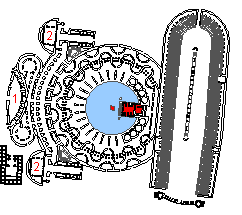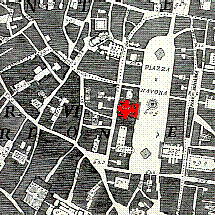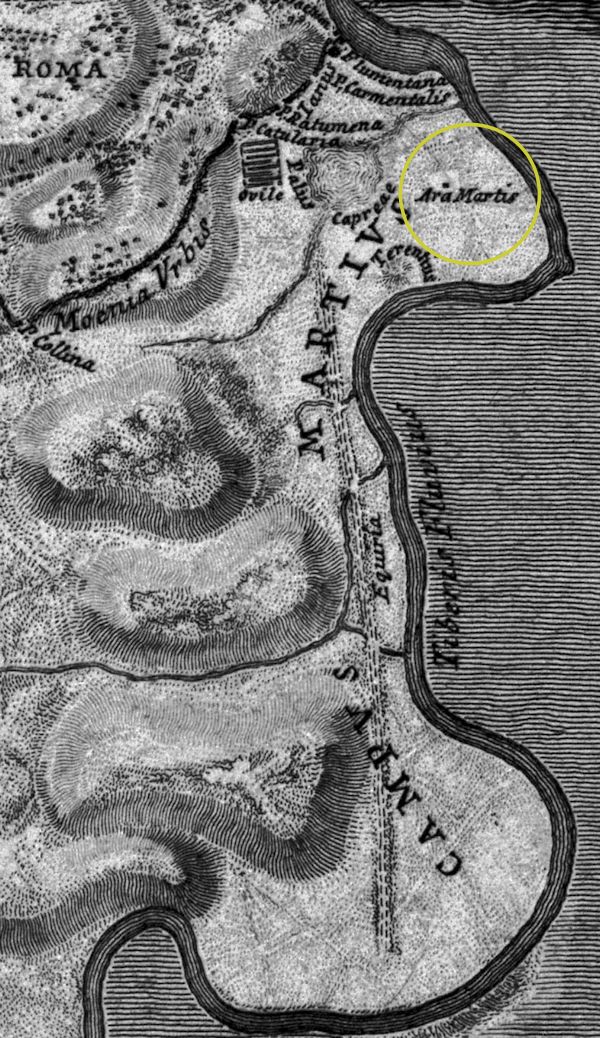The name campus Martius was derived from an ancient altar of Mars, ascribed by tradition to Romulus, which probably stood east of the Pantheon near the via del Seminario [about halfway between the baths of Agrippa and the Arx].
(Platner)
1998.04.12
Ara Martis
...significance of the Templum and Ara Martis that is situated next to the Circus Agonalis. ...this altar and temple to Mars are representative of the very original altar to Mars from which the entire campus Martius receives its name--indeed this altar is the very first "structure" of the campus.
...now knowing the program of the Alexander Severus complex. ...the porticus providing shade from the heat of the day. ...the temple and altar of Mars is surrounded by a very generous public amenity.
1998.07.23
Mars (Martis)
The Ara Martis, situated within the Campus Martius proper, represents the original altar to Mars, and thus fittingly becomes the centerpiece and focal point of an elaborate circular architectural composition which includes a temple to Mars, a Porticus Praebentes umbraculum diei ab aesti (a porticus providing shade from the heat of the day), and the Domus Alexandri Severi (the imperial residence of Alexander Severus). Furthermore, a large circular pool around the altar of Mars not only sets it apart, but also adds distinction by making it "untouchable" as well. Judging by its surroundings and it pivotal position, Piranesi's delineation of the Ara Martis clearly indicates a very special place.

The Ara Martis is first surrounded by a circular pool, and then by a Templum Martis (bottom), a shady porticus (left, right), and the imperial residence of Alexander Severus (above)
1998.08.09
Alexander Severus
Alexander Severus... ...two of the buildings within the Ichnographia--Domus Alexandri Severi and Porticus Alexandri Severi--have a close connection to Mars. The Domus Alexandri Severi is part of the compound enclosing the original altar of Mars, and the Porticus is the last building along the Equiria.
...it is interesting to note that Alexander Severus had considered dedicating a temple to Jesus, and that the military under his reign suffered significant losses. ...willing to propose that Piranesi uses (the buildings of) Alexander Severus as signifying the beginning of the end. If this is so, Piranesi is especially clever because he associates the beginning of the end directly with the Campo Marzio's true beginnings. Furthermore, Alexander Severus then signifies the beginning of the pagan-Christian inversion. ...there are even inversion motifs evident in the porticus around the altar of Mars and the porticus at the end of the Equiria.
| |
1999.04.21
21 April 1999 (Rome's birthday)
The path that ultimately lead me to Helena began with my learning about a deliberate connection between Piranesi's Ichnographia Campus Martius and Saint Agnes of Rome. According to ancient tradition, the first "structure" within the Campus Martius was an altar erected by Romulus in honor of his father Mars. Piranesi situates the Ara Martis within the generally accepted location of the original altar, that is, within the area between the present day Piazza Navona and the Tiber to the west. In Piranesi's plan, the altar of Mars is within a circular pool in front of a Temple of Mars and is furthermore surrounded by an extensively curvilinear porticus. Additionally, the Domus Alexandri Severus (1) flanked by two Sessorium (2) is to the west.
 
Investigating the meaning of Piranesi's Ara Martis layout, I looked to Nolli's 1748 Plan of Rome for a possible connection. I chose this approach because I had already learned that Piranesi indeed sometimes cleverly disguised links between his Ichnographia and Nolli's plan. The only potential tie between the two maps at the Ara Martis juncture is the coinciding position of the Templum Martis and the baroque church of St. Agnes on the Piazza Navona. At this point it became necessary for me to investigate the story of Saint Agnes.
Saint Agnes died in Rome circa 249 as a thirteen year old virgin and martyr. "Her riches and beauty excited the young noblemen of the first families of Rome to contend as rivals for her hand. Agnes answered them all that she had consecrated her virginity to a heavenly husband, who could not be beheld by mortal eyes. Her suitors, finding her resolution unshakable, accused her to the governor as a Christian, not doubting that threats and torments would prove more effective with one of her tender years on whom allurements could make no impression."1 As a form of torture, Agnes was sent to a brothel where her vow of virginity would be threatened and almost certainly eradicated. According to the legend, however, an angel protected Agnes while she was in the brothel, and subsequently Agnes was put to death. The traditional location of the brothel of Agnes' torture is the site of St. Agnes on the Piazza Navona. Moreover, the subsequent execution of Agnes sent shockwaves throughout both pagan and Christian Rome because the worst possible thing any Roman could do was to kill a virgin. Suddenly, and ironically, the Roman persecution of Christians took on the guise of a pagan moral dilemma.
The martyrdom of Agnes signifies a pivotal point of pagan-Christian inversion, and this inversion is precisely what Piranesi delineates within the complex of the Ara Martis. First, the co-positioning of the Templum Martis and the church of St. Agnes represents the origin of Rome itself when Mars raped the Vestal Virgin Rhea, who subsequently became mother to Romulus and Remus. Second, the emperor Alexander Severus is known for having been very interested and sympathetic towards Christianity, to the point where he seriously considered proclaiming Jesus as one of the official Roman gods as well as carving the (inverting) words "do unto others as you would have them do unto you" over the door of his house. Third, Sessorium is a direct reference to the Palatium Sessorianum, the imperial estate that became Helena's residence in Rome after 312, and soon thereafter the church of Santa Croce in Gerusalemme. It seems quite evident that Piranesi was well aware of early Christian history, including its architectural history.
Personally, I wonder whether Piranesi recognized Helena as an architect as well.
1 Herbert Thurston, S.J. and Donald Attwater, editors, "St Agnes" in Butler's Lives of the Saints (New York: P.J. Kenedy & Sons, 1956), v. 1, pp. 133-4.
1999.11.21
Pagan - Christian - Triumphal Way
3123h
3123i
3123j
3123k
2002.06.12
...first encountered the word/name Sessorium
2002.09.09 11:35
"Piranesi Police"
I wanted to mention a piece entitled "Piranesi Police" where I will write about a police station that Piranesi positioned within the Campo Marzio, which is next to a house of prostitution, next to one of the Sessorium, next to the 'sinuous' porticus around the small body of water reflecting the altar of Mars, which is indeed the first historical erection in the Campo Marzio (not counting when Mars raped a Vestal Virgin, of course).
2007.11.09 10:56
It rocked Eisenman on his chair...
Giovanni Battista Piranesi died today in 1778, on the feast of the dedication of the Basilica Constantiniani (known today as the Basilica of St. John Lateran), the first Christian basilica in Rome.
"Piranesi uses the Rome that was extent in the eighteenth century as a starting point, but that possesses no original value; it is merely a being in the present. From this existential moment of being, he takes buildings that existed in the first and second centuries, in Imperial Rome, and places them in the same framework of time and space as the eighteenth-century city."
--Peter Eisenman, "Notations of Affect. An Architecture of Memory" in Pathos, Affect, Gefühl (Berlin: Walter de Gruyter GmbH, 2004), pp.504-11.
If you actually study the Campo Marzio you'll find the starting point, framework and the millennium's worth of buildings that Piranesi utilized. First there are the altar and race course dedicated to Mars by Romulus in the mid-eighth century BC. Incidentally, this is how the Campo Marzio received its name--the fields of Mars. And to manifest the framework there is the last Imperial artifact of the Campo Marzio, the sepulcher of Empress Maria, wife of Honorius, from the early 5th century AD. Indeed the sarcophagus of Empress Maria holds a key position within the Il Campo Marzio publication. And to complete the framework, the last page of Il Campo Marzio depicts a double theater.
Palus Caprae 283b
2018.12.01
The earliest center in Rome for cultivating Mars as a deity was the Altar of Mars (Ara Martis) in the Campus Martius ("Field of Mars") outside the sacred boundary of Rome (pomerium). The Romans thought that this altar had been established by the semi-legendary Numa Pompilius, the peace-loving successor of Romulus. [Lawrence Richardson, A New Topographical Dictionary of Ancient Rome (Johns Hopkins University Press, 1992), p. 245.]
en.wikipedia.org/wiki/Mars_(mythology)
| |

Fig. I Campum Martium demonstrans ab Romulo consecratum ejusque usus prius quam ab Tarquinijs occuparetur
State of the Campus Martius from the time of Romulus until the rule of the Tarquinian kings
|






